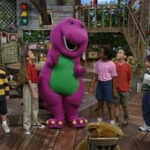As connoisseurs of cinema that dares to be different, we at ten-dance.com pride ourselves on unearthing those hidden gems, the movies that spark conversations and leave a lasting impression. Forget your run-of-the-mill blockbusters; we delve into the wonderfully weird and wildly obscure. This week, we’re plunging headfirst into a film so bizarre, so delightfully off-kilter, it might just redefine your definition of “dance movies”: Dancing Ninja.
Now, the title itself might conjure images of graceful leaps and powerful kicks intertwined with rhythmic movement, and you wouldn’t be entirely wrong. Dancing Ninja arrives as a spiritual successor to Beverly Hills Ninja, a film that, while having its moments, didn’t exactly set the world on fire. So, expectations were…tempered. However, with the legendary David Hasselhoff gracing the cast, there was a glimmer of hope for something memorably eccentric. And eccentric it certainly is.
David Hasselhoff in Dancing Ninja movie poster, a hilariously bad dance movie featuring David Hasselhoff and Lucas Grabeel, reviewed on ten-dance.com as a must-see for fans of movies about dancing.
The narrative of Dancing Ninja orbits around Ikki, a young protagonist discovered adrift at sea in a chest, engaging with a baguette as a babe – a scene that truly must be witnessed to be believed. Raised by Asian parents in Asia, Ikki, despite his upbringing, speaks perfect English with an American accent, a detail the film breezes past with remarkable nonchalance. Undeterred by minor details like logic, Ikki aspires to martial arts prowess, enrolling in a Kung Fu class only to discover… he’s not naturally gifted. Instead of dedicating himself to traditional training, Ikki finds his calling in the dazzling world of dance arcade machines. Yes, you read that correctly. He hones his fighting skills through dance games, a concept that, remarkably, is the most sensible element of the entire film.
Driven by the belief that he is the prophesied Dancing Ninja, Ikki’s path takes a turn for revenge when his Kung Fu master meets his demise at the hands of… David Hasselhoff. Hasselhoff’s character is, naturally, plotting nefarious deeds, and Ikki, fueled by dance-infused vengeance, embarks on a journey to California to confront him. Because, as we all know, dance legends are built on avenging fallen Kung Fu masters.
Accompanying Ikki on this bizarre quest is a Kung Fu classmate whose primary attribute is being slightly less inept than Ikki. Together, they navigate the cultural landscape of California, engaging in spontaneous dance-offs in nightclubs and generally causing comedic chaos. Adding another layer of absurdity, Ikki’s adoptive parents are revealed to be in the adult film industry. Before his departure, Ikki receives some sage advice from his father: carnal knowledge is the key to unlocking true ninja potential. Thus, Ikki’s California adventure takes on a dual purpose: stopping Hasselhoff and, uh, getting lucky with his travel companion.
This leads to a series of increasingly surreal plot points. Ikki discovers that grabbing his female companion’s breasts allows him to commune with his deceased Kung Fu master, seeking guidance on how to thwart Hasselhoff’s celebrity-obliterating schemes. The film then gifts us with multiple scenes of our hero engaging in strategic boob-grabbing as a form of spiritual consultation – a cinematic choice that firmly cements Dancing Ninja‘s place in the pantheon of “unintentionally hilarious Movies About Dancing”.
The narrative escalates further when Ikki and his companion find themselves ensnared in a net. In a moment of what can only be described as cinematic inspiration, they decide to consummate their burgeoning relationship. During this intimate scene, Ikki performs a series of pelvic thrusts, accompanied by unexplained bursts of light emanating from his groin. This, apparently, is how one “levels up” in the world of dance-fighting ninjas, granting him enhanced ninja abilities. Let’s not forget, this is the same Lucas Grabeel from High School Musical, starring in what appears to be marketed, at least vaguely, towards families.
Ultimately, Ikki and his companion triumph over Hasselhoff, celebrate with further romantic entanglement, and the credits roll. Leaving the viewer to ponder, “What exactly did I just witness?” Dancing Ninja oscillates wildly between genres, seemingly unsure if it’s a children’s film, an adult comedy, a dance movie, or a martial arts flick. It throws in adult themes, dance sequences, Hasselhoff in questionable swimwear, and plot holes large enough to drive a truck through. Important scrolls appear and vanish without explanation, wigs are donned and discarded with abandon – it’s a beautiful mess.
Yet, amidst the chaos, there’s a strange charm. The acting is surprisingly competent, and some of the intended jokes actually land. Dancing Ninja transcends its flaws to become a movie that’s “so bad, it’s good.” It possesses that rare quality of cinematic trainwrecks that become cult classics, destined for late-night viewings and ironic appreciation. In years to come, Dancing Ninja might just achieve The Room-esque levels of infamy, a testament to its sheer, unadulterated bonkers nature.
In conclusion, Dancing Ninja, a film that boldly asks, “What if dance fighting was a legitimate martial art?”, teaches us some valuable lessons:
- Boobs are a viable communication tool with the spirit world.
- Dance and combat are, in fact, interchangeable skills.
- Trusting David Hasselhoff to deliver cinematic absurdity is never a mistake.

